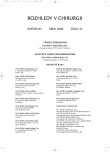Arthroscopic Management of Traumatic Luxation of the Patella
Artroskopické ošetření traumatické luxace pately
Cíl:
Autoři hodnotí retrospektivně artroskopické ošetření akutní traumatické luxace pately.
Materiál:
V letech 1999–2003 ošetřili autoři 57 pacientů s akutní traumatickou luxací pately, 36 žen, 21 mužů, ve věku 16–40 let. V případě výrazné lateralizace pately provedli pod artroskopickou kontrolou suturu poraněného mediálního retinakula, při přetrvávající lateralizaci pately současně i laterální release pately. Čerstvé poranění chrupavky pately nalezli u 34 pacientů (59 %), poranění hrany zevního kondylu femuru u 19 pacientů (33 %) Chondromalacii pately 1.–2. stupně nalezli v 16 případech. Volné kousky chrupavky v kloubu nalezli u 18 pacientů. Rekonstrukci chrupavky provedli u rozsáhlých poranění chrupavky u 13 pacientů.
Výsledky:
Hodnocení od úrazu a operace bylo 1–4 roky. Recidiva luxace pately byla zaznamenána v 1 případě (2 %), novým úrazem při kontaktním sportu (přímým nárazem). Hodnocení podle Lysholm skore bylo v 93 % výborné a dobré, v 7 % uspokojivé. Podle hodnocení podle Macnaba udávalo 79 % pacientů výsledky výborné, 21 % dobré.
Závěr:
Šetrnou operační technikou a následnou správnou rehabilitací lze optimalizovat hojení poraněné tkáně a zabránit recidivujícím luxacím pately i dalšímu opotřebení chrupavek femoropatelárního skloubení.
Klíčová slova:
patela – luxace – artroskopie – stabilizace
Authors:
L. Paša; S. Kalandra; I. Melichar; A. Bilik; R. Suchomel
Authors‘ workplace:
Klinika traumatologie LF MU Brno, přednosta: prof. MUDr. Peter Wendsche, CSc
Published in:
Rozhl. Chir., 2006, roč. 85, č. 10, s. 530-535.
Category:
Monothematic special - Original
Overview
Aim:
The authors present a restrospective assessment of acute traumatic patellar luxation.
Material:
From 1999 to 2003, the authors treated 57 patients with acute traumatic patellar luxations, including 36 females and 21 males, the age range was 16–40 years. In cases of marked lateralization of the patella, the injured medial retinaculum was sutured under arthroscopic control. Furthermore, should the lateralization persist, lateral release of the patella was conducted. Early patellar cartillage injuries were detected in 34 subjects (59%), injuries of the lateral femoral condyle in 19 subjects (33 %). Patellar chondromalacia, grade 1–2 was diagnosed in 16 subjects. Free cartillagenous particles within the joint were detected in 18 subjects. Reconstruction of the cartillage was conducted in extensive injuries in 13 subjects.
Results:
The subjects were assessed 1–4 years after the injuries and surgery. In one case (2%), a relaps of the patellar luxation, due to a new contact sport injury (a direct impact), was recorded. Assessment results, using the Lysholm score, were defined as follows: 93%-excellent and good, 7% fair.
Conclusion:
Sparing surgical techniques, followed by appropriate rehabilitation care, may optimalize the healing process of the injured tissue and prevent relapses of patellar luxations, as well as further wearing of femoropatellar cartillages.
Key words:
patella – luxation – arthroscopy – stabilisation
Labels
Surgery Orthopaedics Trauma surgeryArticle was published in
Perspectives in Surgery

2006 Issue 10
- Metamizole vs. Tramadol in Postoperative Analgesia
- Metamizole at a Glance and in Practice – Effective Non-Opioid Analgesic for All Ages
- Possibilities of Using Metamizole in the Treatment of Acute Primary Headaches
Most read in this issue
- Arthroscopic Management of Traumatic Luxation of the Patella
- Complications of the Longo Procedure – Rectal Occlusion
- Morgagni Diaphragmatic Hernia in Childhood
- Rates and Histological Characteristics of Rectal Polyps in Childhood
